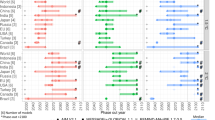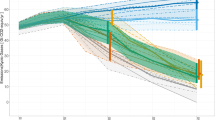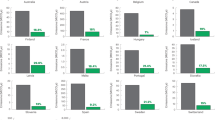Abstract
The Paris Agreement requires countries to articulate near-term emissions reduction strategies through to 2025 or 2030 by communicating nationally determined contributions (NDCs), as well as encouraging the formulation of long-term low-emission development strategies (Article 4.19)1. In response, many countries have either submitted or are preparing mid-century strategies2. Most NDCs set high-level near-term goals—such as limits on emissions or emissions intensity3—which do not provide information about the extent to which they lay the foundations of technology, infrastructure and institutions for deeper reductions in the future, which is a key question for decision makers. Here, using a state-level model of the US embedded within a global integrated assessment model4,5, we demonstrate that although the US NDC lies on a straight-line emissions pathway towards its mid-century strategy, the resulting energy system transitions involve nonlinear transformations. The rates of capacity additions and capital investments in electricity generation beyond 2025 are more than three times the rates during the next decade. Our results demonstrate the need for global stocktaking exercises to evaluate the NDCs using metrics broader than emissions to better illuminate their effectiveness in addressing the Paris Agreement’s long-term goals6,7.
This is a preview of subscription content, access via your institution
Access options
Access Nature and 54 other Nature Portfolio journals
Get Nature+, our best-value online-access subscription
$29.99 / 30 days
cancel any time
Subscribe to this journal
Receive 12 print issues and online access
$209.00 per year
only $17.42 per issue
Buy this article
- Purchase on Springer Link
- Instant access to full article PDF
Prices may be subject to local taxes which are calculated during checkout



Similar content being viewed by others
Change history
21 November 2017
In the version of this Article previously published, technical problems led to the wrong summary appearing on the homepage, and an incorrect Supplementary Information file being uploaded. Both errors have now been corrected.
References
Adoption of the Paris Agreement FCCC/CP/2015/L.9/Rev.1(UNFCCC, 2015).
Communication of Long-Term Strategies (UNFCCC, 2016); http://unfccc.int/focus/long-term_strategies/items/9971.php
INDCs as Communicated by Parties (UNFCCC, 2015); http://www4.unfccc.int/submissions/indc/Submission%20Pages/submissions.aspx
Iyer, G. et al. GCAM-USA Analysis of US Electric Power Sector Transitions (Pacific Northwest National Laboratory, 2017); http://www.pnnl.gov/main/publications/external/technical_reports/PNNL-26174.pdf
GCAM v4.3 Documentation (Joint Global Change Research Institute, 2016); http://jgcri.github.io/gcam-doc/toc.html
Sachs, J., Schmidt-Traub, G. & Williams, J. H. Pathways to zero emissions. Nat. Geosci. 9, 799–801 (2016).
Peters, G. P. et al. Key indicators to track current progress and future ambition of the Paris Agreement. Nat. Clim. Change 7, 118–122 (2017).
Rogelj, J. et al. Paris Agreement climate proposals need a boost to keep warming well below 2 °C. Nature 534, 631–639 (2016).
Synthesis Report on the Aggregate Effect of the Intended Nationally Determined Contributions (UNFCCC, 2015); http://unfccc.int/resource/docs/2015/cop21/eng/07.pdf
Aldy, J. et al. Economic tools to promote transparency and comparability in the Paris Agreement. Nat. Clim. Change 6, 1000–1004 (2016).
United States Mid-Century Strategy for Deep Decarbonization (The White House, Washington, D.C., 2016); https://obamawhitehouse.archives.gov/sites/default/files/docs/mid_century_strategy_report-final.pdf
US Greenhouse Gas Inventory Report (U.S. Environmental Protection Agency, 2016); https://www.epa.gov/ghgemissions/us-greenhouse-gas-inventory-report-1990-2014
Williams, J. H. et al. Pathways to Deep Decarbonization in the United States (Deep Decarbonization Pathways Project of the Sustainable Development Solutions Network and the Institute for Sustainable Development and International Relations, 2014).
Fawcett, A. A., Clarke, L. E. & Weyant, J. The EMF24 study on US technology and climate policy strategies. Energy J. 35, 1–7 (2014).
Fawcett, A. A., Calvin, K. V., de la Chesnaye, F. C., Reilly, J. M. & Weyant, J. P. Overview of EMF 22 US transition scenarios. Energ. Econ. 31, S198–S211 (2009).
Wilson, C., Grubler, A., Bauer, N., Krey, V. & Riahi, K. Future capacity growth of energy technologies: are scenarios consistent with historical evidence? Climatic Change 118, 381–395 (2012).
van Sluisveld, M. A. E. et al. Comparing future patterns of energy system change in 2 °C scenarios with historically observed rates of change. Global Environ. Change 35, 436–449 (2015).
IPCC Climate Change 2014: Synthesis Report (eds Core Writing Team, Pachauri, R. K. & Meyer, L. A.) (IPPC, 2015).
Cramton, P., Ockenfels, A. & Stoft, S. Capacity market fundamentals. Econ Energy Env. Pol. 2, 27–46 (2013).
Form EIA-860 Detailed Data (US Energy Information Administration, 2016); https://www.eia.gov/electricity/data/eia860/
Davis, S. J. & Socolow, R. H. Commitment accounting of CO2 emissions. Environ. Res. Lett. 9, 084018 (2014).
World Energy Investment Outlook (International Energy Agency, Paris, France, 2014); https://www.iea.org/publications/freepublications/publication/WEIO2014.pdf
Annual Energy Outlook 2016 with Projections to 2040 (US Energy Information Administration, 2016); https://www.eia.gov/outlooks/aeo/tables_ref.cfm
Greenblatt, J. B. & Wei, M. Assessment of the climate commitments and additional mitigation policies of the United States. Nat. Clim. Change 6, 1090–1093 (2016).
Iyer, G. et al. Diffusion of low-carbon technologies and the feasibility of long-term climate targets. Technol. Forecast. Soc. Change. 90, 103–118 (2015).
Iyer, G. et al. Improved representation of investment decisions in assessments of CO2 mitigation. Nat. Clim. Change 5, 436–440 (2015).
Williams, J. H., Haley, B. & Jones, R. Policy Implications of Deep Decarbonization in the United States (Deep Decarbonization Pathways Project of the Sustainable Development Solutions Network and the Institute for Sustainable Development and International Relations, 2015).
Energy CO2 Emissions Impacts of Clean Energy Technology Innovation and Policy (US Department of Energy, 2017); https://energy.gov/sites/prod/files/2017/01/f34/Energy%20CO2%20Emissions%20Impacts%20of%20Clean%20Energy%20Technology%20Innovation%20and%20Policy
Calvin, K. et al. Trade-offs of different land and bioenergy policies on the path to achieving climate targets. Climatic Change 123, 691–704 (2013).
Hejazi, M. I. et al. 21st century United States emissions mitigation could increase water stress more than the climate change it is mitigating. Proc. Natl Acad. Sci. USA 112, 10635–10640 (2015).
van der Zwaan, B. C. C., Calvin, K. V. & Clarke, L. E. Climate mitigation in Latin America: implications for energy and land use. Energy Economics 56, 495–498 (2016).
Calvin, K. et al. The role of Asia in mitigating climate change: Results from the Asia modeling exercise. Energ. Econ. 34, S251–S260 (2012).
Edmonds, J., Clarke, J., Dooley, J., Kim, S. & Smith, S. Stabilization of CO2 in a B2 world: insights on the roles of carbon capture and disposal, hydrogen, and transportation technologies. Energy Econ. 26, 517–537 (2004).
Kim, S., Edmonds, J., Lurz, J., Smith, S. & Wise, M. The ObjECTS framework for integrated assessment: hybrid modeling of transportation. Energy J. 27, 63–91 (2006).
Wigley, T. M. MAGICC/SCENGEN 5.3: User Manual Version 2 (NCAR, 2008).
Clarke, J. F. & Edmonds, J. Modelling energy technologies in a competitive market. Energ. Econ. 15, 123–129 (1993).
Iyer, G., Hultman, N., Fetter, S. & Kim, S. H. Implications of small modular reactors for climate change mitigation. Energ. Econ. 45, 144–154 (2014).
Ramana, M. V. Nuclear power: economic, safety, health, and environmental issues of near-term technologies. Annu. Rev. Env. Resour. 34, 127–152 (2009).
Hultman, N. & Koomey, J. G. Three Mile Island: the driver of US nuclear power’s decline? B. Atom. Sci. 69, 63–70 (2013).
Hultman, N. E. The political economy of nuclear energy. WIRES Clim. Change 2, 397–411 (2011).
Joskow, P. L. & Parsons, J. E. The Future of Nuclear Power after Fukushima (MIT Center for Energy and Environmental Policy Research, 2012).
Leung, D. Y. C., Caramanna, G. & Maroto-Valer, M. M. An overview of current status of carbon dioxide capture and storage technologies. Renew. Sust. Energ. Rev. 39, 426–443 (2014).
Davies, L. L., Uchitel, K. & Ruple, J. Understanding barriers to commercial-scale carbon capture and sequestration in the United States: An empirical assessment. Energy Policy 59, 745–761 (2013).
Wennersten, R., Sun, Q. & Li, H. The future potential for carbon capture and storage in climate change mitigation—an overview from perspectives of technology, economy and risk. J. Clean. Prod. 103, 724–736 (2015).
Tavoni, M., De Cian, E., Luderer, G., Steckel, J. C. & Waisman, H. The value of technology and of its evolution towards a low carbon economy. Climatic Change 114, 39–57 (2012).
Clarke, L. et al. in Climate Change 2014: Mitigation of Climate Change (eds Edenhofer, O. et al.) Ch. 6 (IPCC, Cambridge Univ. Press, 2014).
Kriegler, E. et al. The role of technology for achieving climate policy objectives: overview of the EMF 27 study on global technology and climate policy strategies. Climatic Change 123, 353–367 (2014).
Riahi, K. et al. Locked into Copenhagen pledges—implications of short-term emission targets for the cost and feasibility of long-term climate goals. Technol. Forecast. Soc. Change 90, 8–23 (2015).
Krey, V., Luderer, G., Clarke, L. & Kriegler, E. Getting from here to there—energy technology transformation pathways in the EMF27 scenarios. Climatic Change 123, 369–382 (2013).
US Department of Energy US Billion-Ton Update: Biomass Supply for a Bioenergy and Bioproducts Industry (Oak Ridge National Laboratory, Oak Ridge, TN, 2011).
Acknowledgements
The authors are grateful for research support provided by the MILES project Consortium under contract to DG CLIMA (No. 21.0104/2014/684427/SER/CLIMA.A.4). This project is funded by the European Union (EU). The views and opinions expressed in this paper are those of the authors alone and can in no way be taken to reflect the views of the EU or any government or organization.
Author information
Authors and Affiliations
Contributions
G.I., L.C. and J.E. designed the research. G.I. wrote the first draft of the paper. C.L. performed the model simulations. All the authors contributed to writing the paper.
Corresponding author
Ethics declarations
Competing interests
The authors declare no competing financial interests.
Additional information
Publisher’s note: Springer Nature remains neutral with regard to jurisdictional claims in published maps and institutional affiliations.
A correction to this article is available online at https://doi.org/10.1038/s41558-017-0027-3.
Electronic supplementary material
Supplementary Information
Supplementary Methods, Supplementary Figures, Supplementary Tables.
Rights and permissions
About this article
Cite this article
Iyer, G., Ledna, C., Clarke, L. et al. Measuring progress from nationally determined contributions to mid-century strategies. Nature Clim Change 7, 871–874 (2017). https://doi.org/10.1038/s41558-017-0005-9
Received:
Accepted:
Published:
Issue Date:
DOI: https://doi.org/10.1038/s41558-017-0005-9
This article is cited by
-
Agricultural impacts of sustainable water use in the United States
Scientific Reports (2021)
-
The surprisingly inexpensive cost of state-driven emission control strategies
Nature Climate Change (2021)
-
A framework for national scenarios with varying emission reductions
Nature Climate Change (2021)
-
Power sector investment implications of climate impacts on renewable resources in Latin America and the Caribbean
Nature Communications (2021)
-
To achieve deep cuts in US emissions, state-driven policy is only slightly more expensive than nationally uniform policy
Nature Climate Change (2021)



